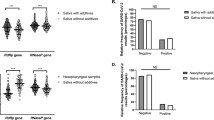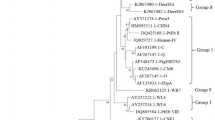Abstract
The purpose of this study was to investigate the usability and performance of the Xpert Norovirus and RidaGene Norovirus assays for the detection of noroviruses in fecal specimens. Of the 186 stool specimens, 53 (28.5%) were considered true-positive for norovirus (NoV). Of the true-positive specimens, Xpert detected 53 and RidaGene detected 52. The respective sensitivity and specificity were 100% and 94.7% [95% confidence interval (CI), 91.0–98.5%] for the Xpert assay, and 98.1% (95% CI, 94.4–100%) and 97.0% (95% CI, 94.1–99.9%) for the RidaGene assay. Positive and negative predictive values (PPVs and NPVs) were 88.3% and 100% for the Xpert assay, and 92.9% and 99.2% for the RidaGene assay, respectively. Based on this study, it can be concluded that there were no significant differences (p-value > 0.5) between the results of the Xpert and RidaGene Norovirus assays. We found that both assays are useful for the detection of noroviruses in clinical stool samples.
Similar content being viewed by others
References
Bruins MJ, Wolfhagen MJ, Schirm J, Ruijs GJ (2010) Evaluation of a rapid immunochromatographic test for the detection of norovirus in stool samples. Eur J Clin Microbiol Infect Dis 29(6):741–743. doi:10.1007/s10096-010-0911-5
Schaub SA, Oshiro RK (2000) Public health concerns about caliciviruses as waterborne contaminants. J Infect Dis 181(Suppl 2):S374–S380. doi:10.1086/315580
Teunis PF, Moe CL, Liu P, Miller SE, Lindesmith L, Baric RS, Le Pendu J, Calderon RL (2008) Norwalk virus: how infectious is it? J Med Virol 80(8):1468–1476. doi:10.1002/jmv.21237
Carter MJ (2005) Enterically infecting viruses: pathogenicity, transmission and significance for food and waterborne infection. J Appl Microbiol 98:1354–1380. doi:10.1111/j.1365-2672.2005.02635.x
Iturriza-Gómara M, Lopman B (2014) Norovirus in healthcare settings. Curr Opin Infect Dis 27(5):437–443. doi:10.1097/QCO.0000000000000094
Bartsch SM, Lopman BA, Ozawa S, Hall AJ, Lee BY (2016) Global economic burden of norovirus gastroenteritis. PLoS One 11(4):e0151219. doi:10.1371/journal.pone.0151219
Rockx B, de Wit M, Vennema H, Vinjé J, de Bruin E, van Duynhoven Y, Koopmans M (2002) Natural history of human calicivirus infection: a prospective cohort study. Clin Infect Dis 35(3):246–253. doi:10.1086/341408
Lopman BA, Reacher MH, Vipond IB, Sarangi J, Brown DW (2004) Clinical manifestation of norovirus gastroenteritis in health care settings. Clin Infect Dis 39(3):318–324. doi:10.1086/421948
Duizer E, Bijkerk P, Rockx B, De Groot A, Twisk F, Koopmans M (2004) Inactivation of caliciviruses. Appl Environ Microbiol 70(8):4538–4543. doi:10.1128/AEM.70.8.4538-4543.2004
Patel MM, Hall AJ, Vinjé J, Parashar UD (2009) Noroviruses: a comprehensive review. J Clin Virol 44(1):1–8. doi:10.1016/j.jcv.2008.10.009
Robilotti E, Deresinski S, Pinsky BA (2015) Norovirus. Clin Microbiol Rev 28(1):134–164. doi:10.1128/CMR.00075-14
Kirby A, Gurgel RQ, Dove W, Vieira SCF, Cunliffe NA, Cuevas LE (2010) An evaluation of the RIDASCREEN and IDEIA enzyme immunoassays and the RIDAQUICK immunochromatographic test for the detection of norovirus in faecal specimens. J Clin Virol 49(4):254–257. doi:10.1016/j.jcv.2010.08.004
Richards GP, Watson MA, Meade GK, Hovan GL, Kingsley DH (2012) Resilience of norovirus GII.4 to freezing and thawing: implications for virus infectivity. Food Environ Virol 4(4):192–197. doi:10.1007/s12560-012-9089-6
Gonzalez MD, Langley LC, Buchan BW, Faron ML, Maier M, Templeton K, Walker K, Popowitch EB, Miller MB, Rao A, Liebert UG, Ledeboer NA, Vinjé J, Burnham CAD (2016) Multicenter evaluation of the Xpert Norovirus assay for detection of norovirus genogroups I and II in fecal specimens. J Clin Microbiol 54(1):142–147. doi:10.1128/JCM.02361-15
Rovida F, Premoli M, Campanini G, Sarasini A, Baldanti F (2016) Evaluation of Xpert® Norovirus assay performance in comparison with real-time RT-PCR in hospitalized adult patients with acute gastroenteritis. Diagn Microbiol Infect Dis 85(4):426–427. doi:10.1016/j.diagmicrobio.2016.05.002
Dunbar NL, Bruggink LD, Marshall JA (2014) Evaluation of the RIDAGENE real-time PCR assay for the detection of GI and GII norovirus. Diagn Microbiol Infect Dis 79(3):317–321. doi:10.1016/j.diagmicrobio.2014.03.017
Vinjé J (2015) Advances in laboratory methods for detection and typing of norovirus. J Clin Microbiol 53(2):373–381. doi:10.1128/JCM.01535-14
Ambert-Balay K, Pothier P (2013) Evaluation of 4 immunochromatographic tests for rapid detection of norovirus in faecal samples. J Clin Virol 56(3):194–198. doi:10.1016/j.jcv.2012.11.001
Acknowledgements
The work at Seinäjoki Central Hospital was part of the TUKE 5050 project and funded by TUKE (Research and Development Project of The Hospital District of South Ostrobothnia).
Author information
Authors and Affiliations
Corresponding author
Ethics declarations
Conflict of interest
The authors have no conflict of interest to declare.
Ethical approval
This article does not contain any studies with human participants or animals performed by any of the authors. Informed consent was obtained from all individual participants included in the study.
Rights and permissions
About this article
Cite this article
Aho-Laukkanen, E., Hirvonen, J.J. & Saha, K. Comparison of Xpert Norovirus and RidaGene Norovirus assays for the detection of noroviruses in clinical fecal specimens. Eur J Clin Microbiol Infect Dis 36, 1019–1022 (2017). https://doi.org/10.1007/s10096-016-2884-5
Received:
Accepted:
Published:
Issue Date:
DOI: https://doi.org/10.1007/s10096-016-2884-5




